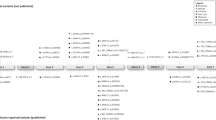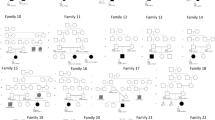Abstract
Background
Juvenile neuronal ceroid lipofuscinosis (JNCL, NCL3, Batten disease) is usually caused by a 1.02-kb deletion in the CLN3 gene. Mutations in the CLN1 gene may be associated with a variant form of JNCL (vJNCL). We report the clinical course and molecular studies in 24 patients with JNCL collected from 1975 to 2010 with the aim of assessing the natural history of the disorder and phenotype/genotype correlations.
Patients and methods
Patients were classified into the groups of vJNCL with mutations in the CLN1 gene and/or granular osmiophilic deposit (GROD) inclusion bodies (n = 11) and classic JNCL (cJNCL) with mutations in the CLN3 gene and/or fingerprint (FP) profiles (n = 13). Psychomotor impairment included regression of acquired skills, cognitive decline, and clinical manifestations of the disease. We used Kaplan-Meier analyses to estimate the age of onset of psychomotor impairment.
Results
Patients with vJNCL showed learning delay at an earlier age (median 4 years, 95% confidence interval [CI] 3.1–4.8) than those in the cJNCL group (median 8 years, 95% CI 6.2–9.7) (P = 0.001) and regression of acquired skills at a younger age. Patients with vJNCL showed a more severe and progressive clinical course than those with cJNCL. There may be a Gypsy ancestry for V181L missense mutation in the CLN1 gene.
Conclusions
The rate of disease progression may be useful to diagnose vJNCL or cJNCL, which should be confirmed by molecular studies in CLN1/CLN3 genes. Further studies of genotype/phenotype correlation will be helpful for understanding the pathogenesis of this disease.



Similar content being viewed by others
References
Aberg L, Järvelä I, Rapola J et al. (1998) Atypical juvenile neuronal ceroid lipofuscinosis with granular osmiophilic deposit-like inclusions in the autonomic nerve cells of the gut wall. Acta Neuropathol 95:306–312
Aberg L, Kirveskari E, Santavuori P (1999) Lamotrigine therapy in juvenile neuronal ceroid lipofuscinosis. Epilepsia 40:796–799
Aberg LE, Bäckman M, Kirveskari E, Santavuori P (2000) Epilepsy and antiepileptic drug therapy in juvenile neuronal ceroid lipofuscinosis. Epilepsia 41:1296–1302
Aberg L, Lauronen L, Hämäläinen J, Mole SE, Autti T (2009) A 30-year follow-up of a neuronal ceroid lipofuscinosis patient with mutations in CLN3 and protracted disease course. Pediatr Neurol 40:134–137
Autti TH, Hämäläinen J, Mannerkoski M, Van Leemput KV, Aberg LE (2008) JNCL patients show marked brain volume alterations on longitudinal MRI in adolescence. J Neurol 255:31226–31230
Das AK, Becerra CH, Yi W et al. (1998) Molecular genetics of palmitoyl-protein thioesterase deficiency in the U.S. J Clin Invest 102:361–370
D'Incerti L (2000) MRI in neuronal ceroid lipofuscinosis. Neurol Sci 21(3 Suppl):S71–S73
Goebel HH (1996) The neuronal ceroid-lipofuscinoses. Semin Pediatr Neurol 3:270–278
Goebel HH, Sharp JD (1998) The neuronal ceroid-lipofuscinoses. Recent advances. Brain Pathol 8:151–162
Goebel HH, Wisniewski KE (2004) Current state of clinical and morphological features in human NCL. Brain Pathol 14:61–69
Goebel HH, Mole SE, Lake BD (1999) The neuronal ceroid lipofuscinosis (Batten disease). In: IOS Press, ed. NCL in different European countries. On behalf of the European Concerted Action Group. Amsterdam, 128–142
Haltia M (2003) The neuronal ceroid-lipofuscinoses. J Neuropathol Exp Neurol 62:1–13
Hofman IL, Taschner PE (1995) Late onset juvenile neuronal ceroid-lipofuscinosis with granular osmiophilic deposits (GROD). Am J Med Genet 57:165–167
Hofmann SL, Das AK, Yi W, Lu JY, Wisniewski KE (1999) Genotype-phenotype correlations in neuronal ceroid lipofuscinosis due to palmitoyl-protein thioesterase deficiency. Mol Genet Metab 66:234–239
Kälviäinen R, Eriksson K, Losekoot M et al. (2007) Juvenile-onset neuronal ceroid lipofuscinosis with infantile CLN1 mutation and palmitoyl-protein thioesterase deficiency. Eur J Neurol 14:369–372
Lauronen L, Munroe PB, Järvelä I et al. (1999) Delayed classic and protracted phenotypes of compound heterozygous juvenile neuronal ceroid lipofuscinosis. Neurology 52:360–365
Lowry OH, Rosebrough NJ, Farr AL, Randall RJ (1951) Protein measurement with the Folin phenol reagent. J Biol Chem 193:265–275
Marshall FJ, de Blieck EA, Mink JW et al. (2005) A clinical rating scale for Batten disease: reliable and relevant for clinical trials. Neurology 65:275–279
Mazzei R, Conforti FL, Magariello A et al. (2002) A novel mutation in the CLN1 gene in a patient with juvenile neuronal ceroid lipofuscinosis. J Neurol 249:1398–1400
Mitchison HM, Hofmann SL, Becerra CH et al. (1998) Mutations in the palmitoyl-protein thioesterase gene (PPT; CLN1) causing juvenile neuronal ceroid lipofuscinosis with granular osmiophilic deposits. Hum Mol Genet 7:291–297
Mole S (2006) Neuronal ceroid lipofuscinoses (NCL). Eur J Paediatr Neurol 10:256–257
Mole SE, Williams RE, Goebel HH (2005) Correlations between genotype, ultrastructural morphology and clinical phenotype in the neuronal ceroid lipofuscinoses. Neurogenetics 6:107–126
Moore SJ, Buckley DJ, MacMillan A et al. (2008) The clinical and genetic epidemiology of neuronal ceroid lipofuscinosis in Newfoundland. Clin Genet 74:213–222
Munroe PB, Mitchison HM, O'Rawe AM et al. (1997) Spectrum of mutations in the Batten disease gene, CLN3. Am J Hum Genet 61:310–316
Philippart M, Chugani HT, Bateman JB (1995) New Spielmeyer-Vogt variant with granular inclusions and early brain atrophy. Am J Med Genet 57:160–164
Santavuori P, Lauronen L, Kirveskari K, Aberg L, Sainio K (2000) Neuronal ceroid lipofuscinoses in childhood. Suppl Clin Neurophysiol 53:443–451
Santavuori P, Vanhanen SL, Autti T (2001) Clinical and neuroradiological diagnostic aspects of neuronal ceroid lipofuscinoses disorders. Eur J Paediatr Neurol 5(Suppl A):157–161
Sarpong A, Schottmann G, Rüther K et al. (2009) Protracted course of juvenile ceroid lipofuscinosis associated with a novel CLN3 mutation (p.Y199X). Clin Genet 76:38–45
Siintola E, Lehesjoki AE, Mole SE (2006) Molecular genetics of the NCLs – status and perspectives. Biochim Biophys Acta 1762:857–864
The International Batten Disease (1995) Isolation of a novel gene underlying Batten disease, CLN3. Cell 82:949–957
Uvebrant P, Hagberg B (1997) Neuronal ceroid lipofuscinoses in Scandinavia. Epidemiology and clinical pictures. Neuropediatrics 28:6–8
Wisniewski KE, Zhong N, Kaczmarski W et al. (1998a) (1998a) Compound heterozygous genotype is associated with protracted juvenile neuronal ceroid lipofuscinosis. Ann Neurol 43:106–110
Wisniewski KE, Zhong N, Kaczmarski W, Kaczmarski A, Sklower-Brooks S, Brown WT (1998b) Studies of atypical JNCL suggest overlapping with other NCL forms. Pediatr Neurol 18:36–40
Wisniewski KE, Kaczmarski A, Kida E et al. (1999) Reevaluation of neuronal ceroid lipofuscinoses: atypical juvenile onset may be the result of CLN2 mutations. Mol Genet Metab 66:248–252
Wisniewski KE, Kida E, Connell F, Zhong N et al. (2000) Neuronal ceroid lipofuscinoses: research update. Neurol Sci 21(3 Suppl):S49–S56
Acknowledgments
We are indebted to Drs Armstrong, Vernet, Vilaseca, Coll and Gort, and the families of the patients for the valuable support and indispensable cooperation, and Dr Marta Pulido for editing the manuscript and editorial assistance (medical editing services were provided on behalf of the authors).
Funding
None
Author information
Authors and Affiliations
Corresponding author
Additional information
Communicated by: Sedel Frederic
Competing interest: None declared.
Rights and permissions
About this article
Cite this article
Pérez-Poyato, MS., Milà Recansens, M., Ferrer Abizanda, I. et al. Juvenile neuronal ceroid lipofuscinosis: clinical course and genetic studies in Spanish patients. J Inherit Metab Dis 34, 1083–1093 (2011). https://doi.org/10.1007/s10545-011-9323-7
Received:
Revised:
Accepted:
Published:
Issue Date:
DOI: https://doi.org/10.1007/s10545-011-9323-7




